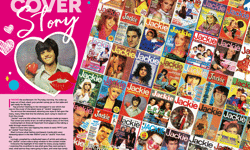
This will be the last of the regular columns I’ve been contributing to InPublishing over the last ten years. Those who find this news too much to bear can draw solace from the promise that I may pop up here from time to time if there’s something I feel I can usefully contribute, or, more likely, if there’s some significant figure from the glory days of the old magazine industry who has gone out with the tide and there’s nobody else around in a position to explain the reasons for their significance. However, I hope that on this occasion you’ll grant me the indulgence of allowing me to recount a few memories from the time, forty years ago, when I began in publishing.
Actually, they’re not memories. To find out what was happening forty years ago this year, when I got my first proper job in the business, as features editor of the recently launched Smash Hits, I had to go and do some research. My starting salary, which was hammered out with the then-publisher in a pub on the corner of Great Pulteney Street, was £4,500 a year. This was supplemented with Luncheon Vouchers, a convention which had been arrived at as a way of motivating staff during one of those government-directed pay freezes with which the 70s were punctuated. In 1979, there wasn’t a lot to spend these on as the cafes of Soho, all of which were Italian-run but had yet to discover cappuccino or any other variety of coffee other than instant. Then again, it wasn’t all bad news on the economic front. Back then, the pound would buy you $2.25.
I went looking in the archives of The Times to see what was happening in the news when I started this job and I was immediately reminded of the fact that The Times was not published for most of the year 1979 because of an industrial dispute between the unions and the owners of the paper. I looked in the archives of The Guardian and saw that there were only two television channels at the time because Channel 4 had obviously not been invented and ITV was off the air for three months as a result of an industrial dispute between the unions and the station’s owners. This was an entirely standard state of affairs in 1979. There was never a time when nobody was striking. Maybe some of those people who are cluttering up the public square at the moment calling to either have their Britain back or to return to the days of unfettered industrial action may care to reflect on some of that.
My starting salary, which was hammered out with the then-publisher in a pub on the corner of Great Pulteney Street, was £4,500 a year.
Smoke filled rooms
Anyway, to work. The magazine was put together in those days, like all magazines, in smokey rooms made noisy by the clacking of typewriters, the ringing of immobile telephones and the arrival and departure of motorcycle messengers. Everything had to be done by hand. Checking anything was a nightmare, involving everything from the Guinness Book Of Hit Singles, old copies of the Rothmans Football Yearbook to a telephone call to the Daily Telegraph Information Service where a helpful operator would tell you the date of Harold Wilson’s resignation or whatever you needed to know. Steve Bush, the magazine’s designer, had to make daily visits to the art supplies shop around the corner to buy new sheets of Letraset to lay out the pages. The colour transparencies were positioned by pointing a projector at a wall on which was affixed a layout sheet and then moving the projector backwards or forwards to get the image to the correct size. The air was so thick with SprayMount, you went home with half the magazine attached to the soles of your shoes. The layouts were taken up to the compositors in Peterborough by a retired printer called Len who used to come every day and return on the train. You often didn’t get an idea of what things were going to look like until it was too late to change them.
Of the future we knew nothing. We didn’t try to imagine it. Nobody could possibly have foreseen that Smash Hits would, within ten years, be selling almost a million copies every fortnight, that it would spearhead a boom in the market for teenage magazines, that most of those teenagers would continue their magazine buying habit into young adulthood and then account for some of the massive sales of titles like FHM and Marie Claire in the 90s and that most of the drab newspapers which appeared to be struggling at the end of the 70s would sprout colour sections, all of which were packed with ideas filched from the magazines that were driving the consumer boom.
In 1979, most magazines were predominantly black and white and cover mounted gifts were no more valuable than flexi discs and badges. We couldn’t possibly have foreseen that by the 90s, people would be giving away things like actual Compact Discs (which clearly had not been invented at the time) on the covers of magazines and that the audience would get so used to them that they would actually tire of them. Nobody had grand ideas. In 1979, nobody had picture researchers or stylists or executive art directors or car accounts or off-sites in foreign climes or PowerPoint. Nobody talked about pitches or copy approval. PRs didn’t “reach out” and would have died of embarrassment if it had been suggested that they remained in the room as an interview was going on.
Everything had to be done by hand. Checking anything was a nightmare.
Right place, right time
When the Golden Age of magazines arrived towards the end of the 80s, we didn’t even know it was happening because the characteristic of a Golden Age, as a wise man said, is that things happen in such a way as to make you think they will happen in that way forever. Let me tell you, they don’t. All the people who worked on Smash Hits, on FHM, on Heat, on More!, on all of the genuinely phenomenally successful, hugely profitable magazines I ever had anything to do with will probably admit to you now that at the time they thought that the reason the magazines were doing so well, were breaking records when it came to circulation and ad sales, was because of them and the unique qualities they brought to the work. If you ask them now, they will admit that a lot of success, like a lot of failure, can be ascribed to lots of factors that are entirely beyond human control and that they were just lucky enough to be along for the ride.
You’re not a genius when it all goes well, nor are you a klutz when it doesn’t. In a few years’ time, there will be people who are currently working for Facebook or Google who will make the same realisation. And, to go back to 1979 for a moment, you can’t possibly be expected to know what’s around the corner. There are no certainties other than this one. Whoever owns the present has a vested interest in pretending that the future will be the same as the present but bigger. And it won’t.
That will be all.
You often didn’t get an idea of what things were going to look like until it was too late to change them.
This article was first published in InPublishing magazine. If you would like to be added to the free mailing list, please register here.












